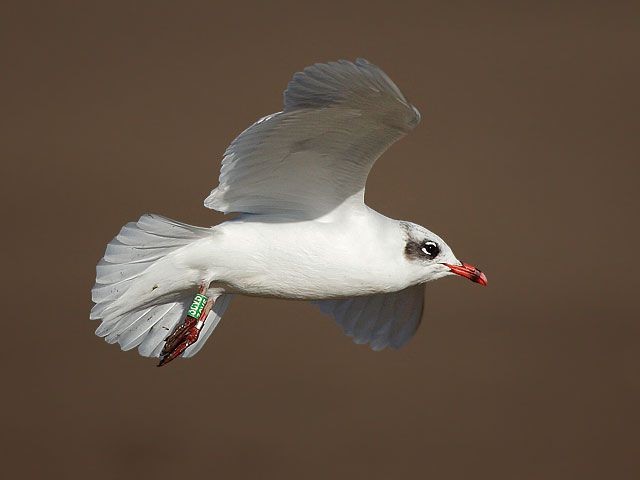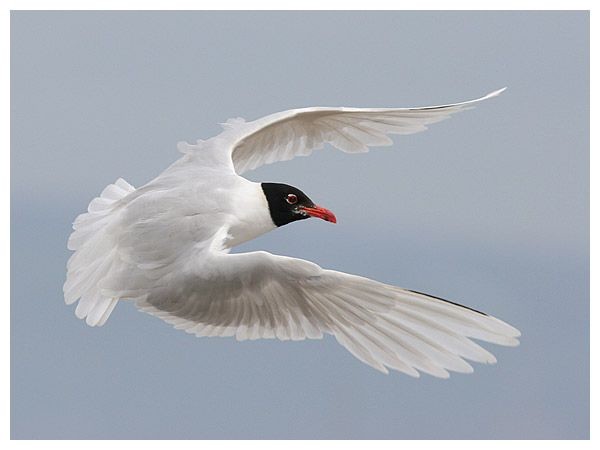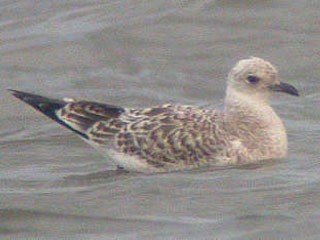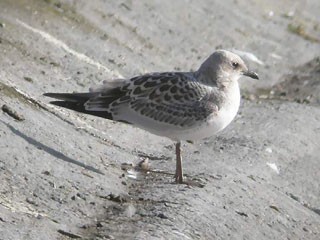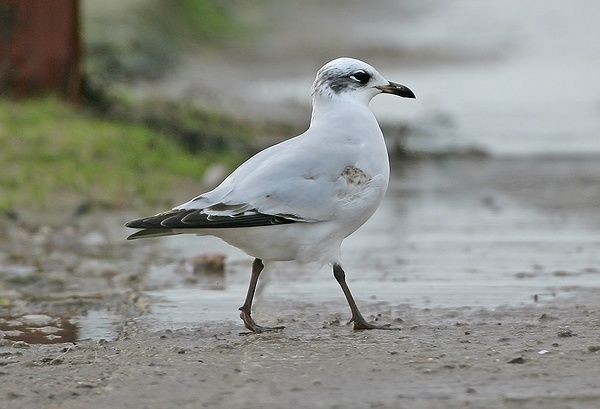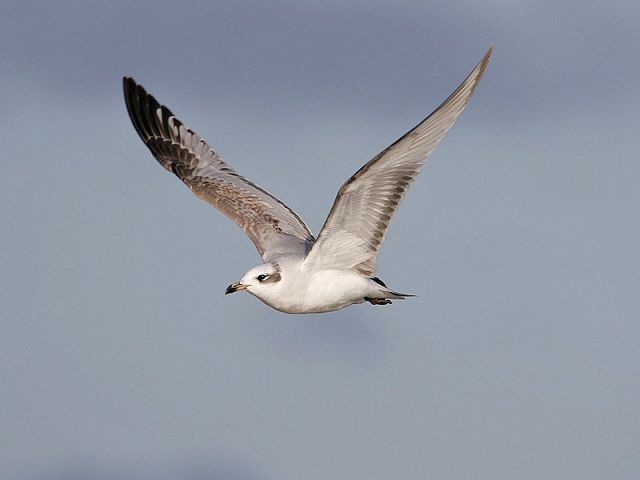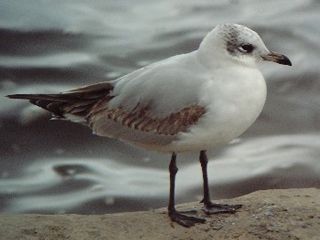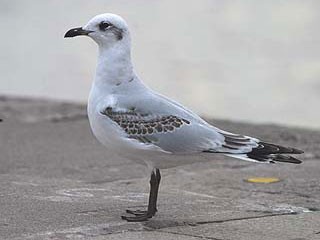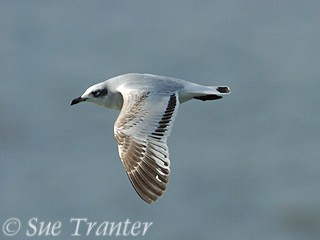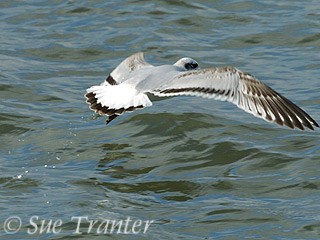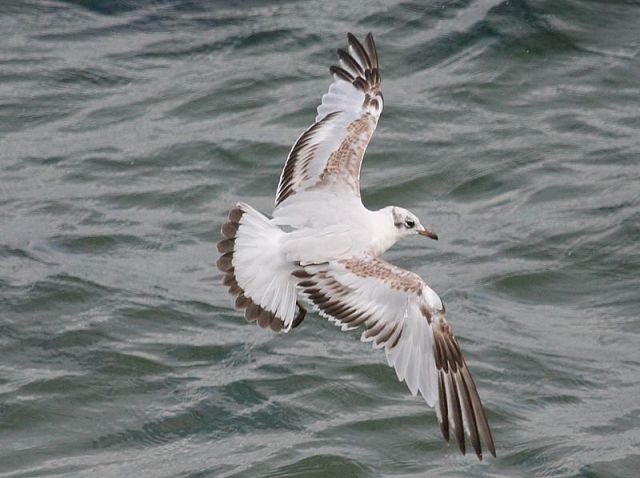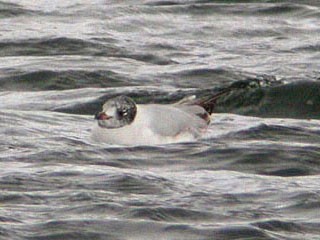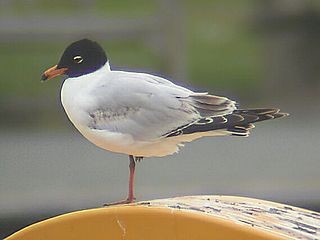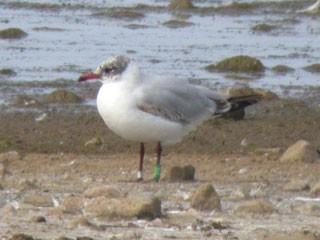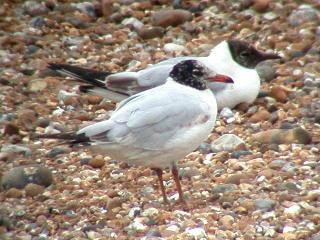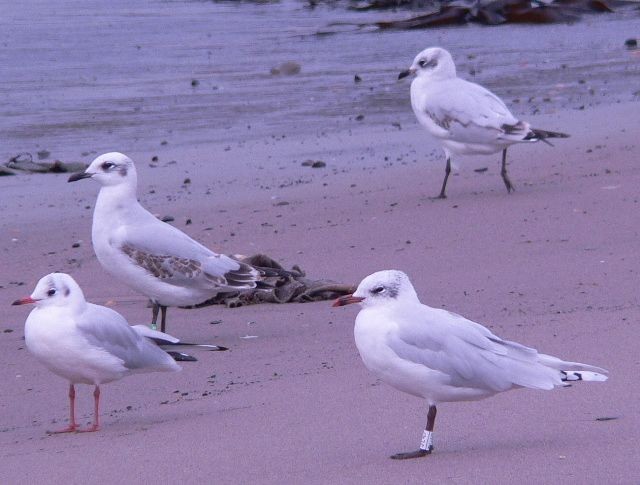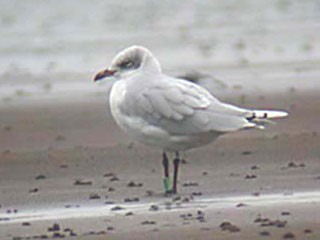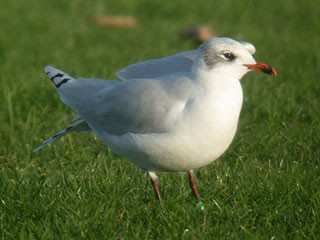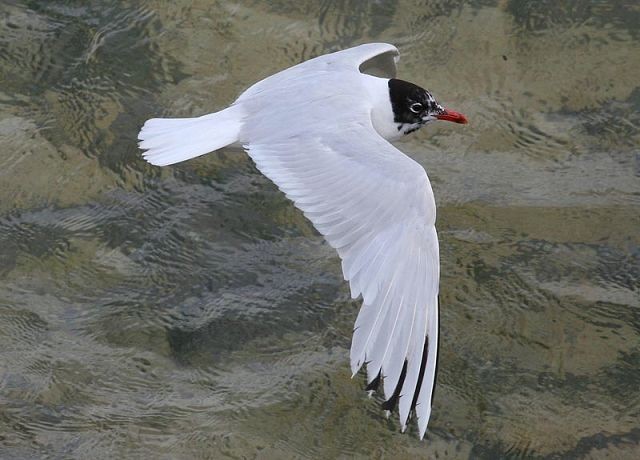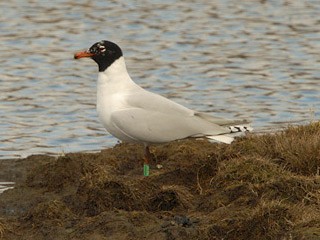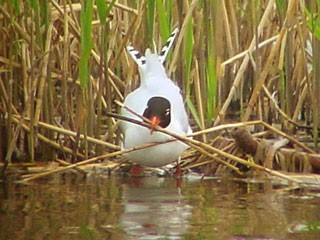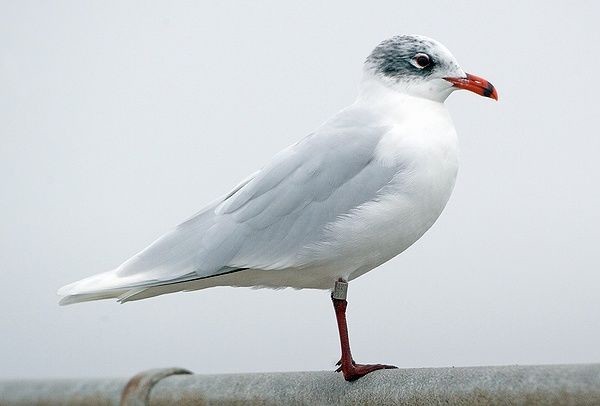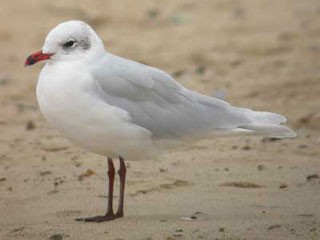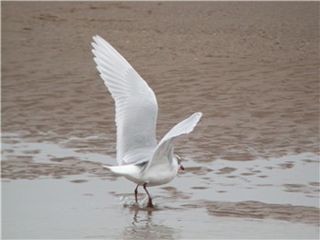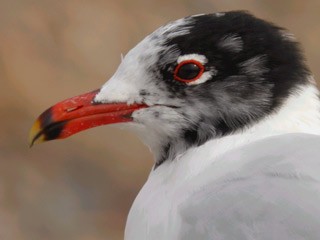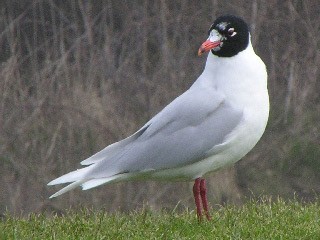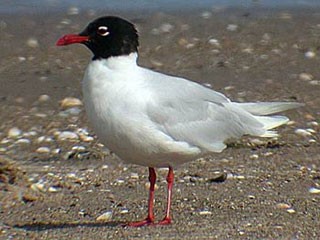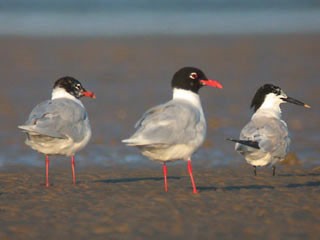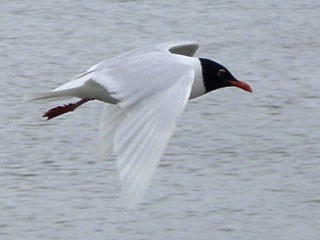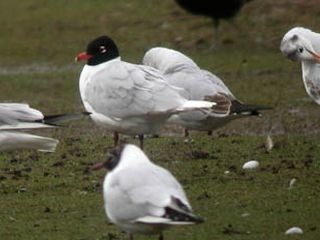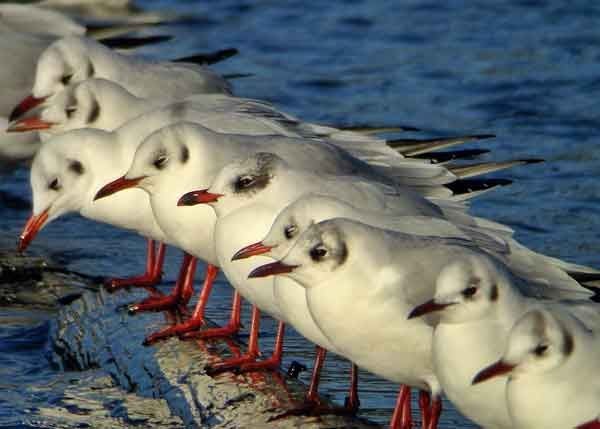![]() |
| Mediterranean Gull: New Brighton, Cheshire (October). Colour-ringing schemes are providing an insight into the movements of this beautiful gull. (Photo: Steve Round) |
Although not a rarity, a summer-plumaged Mediterranean Gull is a match in looks for any of the rare gulls to occur in Britain and Ireland. Despite increasing numbers, away from the south coast the species is scarce enough to make finding a 'Med Gull' in your local gull flock or gull roost a notable event.
Globally, the distribution of this striking gull is restricted to a few localities in Europe, most particularly in the northern part of the Black Sea, where 245,000 pairs breed in the Ukraine. Elsewhere, it has a fragmented distribution across Europe, with the northwestern limit in Britain and Ireland. The world population is put at between 120,000 and 300,000 pairs, 99% of which are in the former USSR. The main wintering area is in the Mediterranean where up to 700,000 winter, most in the southern Mediterranean. Smaller numbers can be found in western and northwest Europe to southern Scandinavia. Ringing studies have highlighted the use of the large river systems to facilitate movement.
![]() |
| Mediterranean Gull: Mumbles, Glamorgan (February). On adults there is a narrow back outer web to the outer primary, though it is extremely difficult to see, but is perfectly illustrated in this superb portrait. (Photo: Tristan Bantock) |
The species was formerly a great rarity in Britain with only four or five records before 1940 and the BBRC accepted ten records in 1958, its first year of adjudicating rare birds, but ceased to consider records after 1962. Since then, there has been a rapid increase in the number of records and breeding was confirmed for the first time in Hampshire in 1968. There has been a slow and steady increase in the breeding population since then and between 90 and 104 pairs bred in 2001, the majority in southern England. Events in Britain have mirrored those in Europe and it is likely that the breeding population will continue to increase over the coming years; similar events occurred in France where the breeding population increased from over 100 pairs in 1991 to nearly 1,400 pairs by 1998. The wintering population of Britain is put at over 1,200 birds with over 100 in Ireland.
As with other gulls, colour-ringing is starting to provide an interesting picture of the movements of birds throughout Europe. The Migration Atlas reported the origins of some of the birds present in Britain and Ireland where 11 were from The Netherlands, five from Germany, three from Hungary and one from the former Yugoslavia.
Juvenile
![]() |
![]() |
| Juvenile: Lowestoft, Suffolk (July). Birds of this age often appear quite subtle in plumage and appear 'soft-faced'. (Photo: Andrew Easton) |
Juvenile: Farmoor Reservoir, Oxfordshire (July). The legs are distinctly long and dark. (Photo: Nic Hallam) |
1st-winter
![]() |
| Mediterranean Gull: Heysham, Lancs (January). Once learnt 1st-winters can be quite obvious birds to pick out. Note the short stout bill, long dark legs and obvious 'mask'. (Photo: Sean Gray) |
![]() |
| Mediterranean Gull: Coalville, Kent (January). In flight look for the unmarked underwing coverts, which are well marked in Common Gulls. Also look for the pale midwing panel and narrow tail band. (Photo: Steve Valentine) |
![]() |
![]() |
| 1st-winter: North Shields, Northumbs (February). Dark mask can appear quite prominent on some birds and bill dark with paler base but not clear cut as in Common Gull. (Photo: John Malloy) |
1st-winter: West Kirby, Cheshire (October). The bill can also appear mostly dark especially earlier in the winter. (Photo: Steve Round) |
![]() |
![]() |
| 1st-winter: Heysham, Lancs (February). Grey mantle and pale mid-wing panel. (Photo: Sue Tranter) |
1st-winter: Heysham, Lancs (February). Striking upperwing pattern and narrow subterminal to the tail. (Photo: Sue Tranter) |
1st-summer
![]() |
| Mediterranean Gull: Whitburn, Durham (July). 1st-summers are similar to 1st-winters with the head moult normally limited to a few feathers on the hindneck though in some the adult summer hood is developed (<5%). a="" few="" replace="" most="" inner="" wing-coverts.="">Photo: Mark Newsome) |
![]() |
![]() |
| 1st-summer: Dix Pit, Oxfordshire (April). Bare parts can vary from quite dull to bright, almost adult colours. (Photo: Nic Hallam) |
1st-summer: Southsea, Hants (June). A small proportion of birds develop a full hood. (Photo: Richard Ford) |
![]() |
![]() |
| 1st-summer: East Chevington, Northumbs (June). Some can appear quite pale-headed. (Photo: Alan Gilbertson) |
1st-summer: Dungeness, Kent (June). The upperparts can appear quite 'bleached' at this time of year. (Photo: John Reeves) |
2nd-winter
![]() |
| Mediterranean Gull: Newbiggin, Northumbs (October). A 2nd-winter and two 1st-winter birds, plus a Black-headed Gull. (Photo: Kris Gibb) |
![]() |
![]() |
| 2nd-winter: Flimby, Cumbria (November). The amount of black in the primaries is variable. (Photo: Tristan Reid) |
2nd-winter: Glasgow, Clyde (December). Bill colour is variable, some with quite red bills. The dark mask usually joins at the rear of the head with variable streaking. (Photo: John Molloy) |
2nd-summer
![]() |
| Mediterranean Gull: Whitburn, Durham (July). Although adult-like there are variable amounts of black in the wing that betray the age of such birds. (Photo: Mark Newsome) |
![]() |
![]() |
| 2nd-summer: Leighton Moss, Lancs (March). White flecks in the hood are frequent, usually on the forehead. (Photo: Philip Tomkinson) |
2nd-summer: undisclosed, Cheshire (April). At this age summer birds can be striking, with an adult-like hood and dark primary markings. (Photo: Mark Jobling) |
Adult winter
![]() |
| Mediterranean Gull: Heysham, Lancs (February). The only potential confusion species is an aberrant Black-headed or Common Gull, but the genuine article is a truly attractive species. (Photo: Sean Gray) |
![]() |
![]() |
| Adult winter: Great Yarmouth, Norfolk (October). Dull red bill with blackish subterminal markings. (Photo: Kevin Elsby) |
Adult winter: Chapel Point, Lincs (October). The broad wings have a subtle grey inner wing contrasting with the white outer wing. (Photo: Steve Botham) |
Adult summer
![]() |
![]() |
| Adult summer: Southsea, Hants (February). Moult to summer plumage takes place between February and April and starts with the crown and ear coverts. (Photo: Marcus Ward) |
Adult summer: Scarborough, Yorks (March). Birds at this time of year can be variable, with the full summer plumaged head present from mid-March onwards, but the white forehead and throat can still be evident in early May. (Photo: PR Baker) |
![]() |
![]() |
| Adult summer: Blackpill, Glamorgan (July). Black hood with striking white eyelids, which can be obvious at quite some range. (Photo: Tristan Bantock) |
Adult summer: Ryde, Isle of Wight (July). Blood-red bill and legs. The white eyelids may join at the back of the eye in males. (Photo: Kris Gillam) |
![]() |
![]() |
| Adult summer: Lowestoft, Suffolk (July). Wings appear transluscent. There is a narrow back outer web to the outer primary (often referred to as p10), but this is extremely difficult to see. (Photo: Mark Breaks) |
Adult summer: Westport Lake, Staffs (March). The bill often has a black subterminal band and pale tip. (Photo: Dave Kelsall) |
![]() |
| Odd one out: Colwick CP, Notts (October). With practice picking out a Med from the crowd becomes quite easy. Here an adult is the fifth bird from the right. (Photo: Darren Chapman) |
References
Brown and Grice. 2005. Birds in England. Poyser, London.
Malling Olsen, K and Larsson, H. 2003. Gulls of Europe, Asia and North America. Helm. London.
Birdlife International. 2004. Birds in Europe: Population estimates, trends and conservation status. Cambridge, UK: Birdlife International. (Birdlife Conservation Series No. 12).
Cramp and Simmons. 2004 Birds of the Western Palearctic interactive.
Published by BirdGuides, Sheffield.
Ogilvie, M. 2004. Rare breeding birds in the United Kingdom in 2002. British Birds 97: 492-536.
Svensson, L., Grant, P.J., Mullarney, K., Zetterstrom, D. 1999. Collins Bird Guide. HarperCollins, London.
Wernham, C., et al. 2002. The Migration Atlas: Movements of the birds of Britain and Ireland. T and AD Poyser, London.
The first version of this article was published in March 2004.
